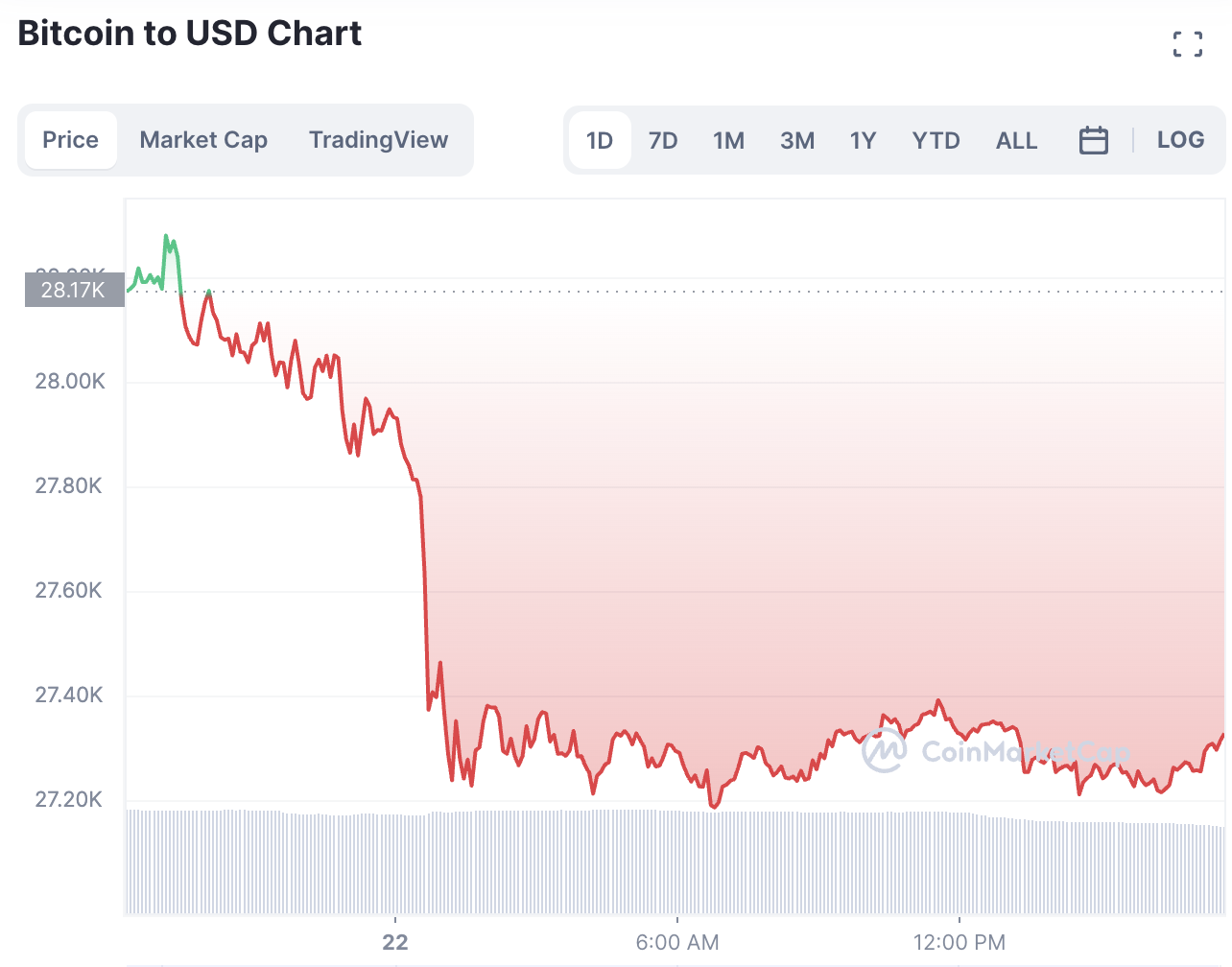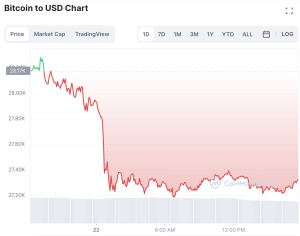Join Our Telegram channel to stay up to date on breaking news coverage
On April 21, 2023, the cryptocurrency market underwent a significant downturn, marking a sharp decline in the prices of major digital assets.
Bitcoin Plunges Triggering Cryptocurrency Market Crash
The flagship cryptocurrency, Bitcoin (BTC), experienced a significant plunge, falling to approximately $27,300, representing a substantial drop from its earlier value. The sudden fall in Bitcoin’s price is believed to have triggered a domino effect across the cryptocurrency market, causing a considerable amount of liquidation activity to occur.
A staggering amount of approximately $200 million worth of digital assets was liquidated over 24 hours. This significant surge in liquidation activity had a profound impact on the overall market, causing a ripple effect that led to a sharp decline
Ethereum, the world’s second-largest cryptocurrency, fell by 4.9%, while XRP, the seventh-largest cryptocurrency, experienced a decline of 5.6%. Similarly, Dogecoin, a popular meme-based cryptocurrency, witnessed a 6.8% drop in its value.
The high volume of liquidations primarily occurred on major cryptocurrency exchanges such as Binance, OKX, Huobi, and Bybit.
Bitcoin and Ethereum saw the most significant liquidations, with $63.03 million and $54.20 million, respectively. Other cryptocurrencies such as Dogecoin, Arbitrum, Chainlink, XRP, Litecoin, and Solana experienced less than $5.5 million in liquidations.
The sudden market downturn highlights the inherent volatility of cryptocurrencies and gives an idea of the risks associated with investing in them. While cryptocurrencies have been celebrated for their potential to deliver exceptional returns, the market’s unpredictable nature means that investments in digital assets should be approached with caution.
As such, it is essential to diversify one’s investment portfolio and conduct thorough research before investing in cryptocurrencies. The current rally for Bitcoin, in particular, was suggested to have a misleadingly low level of demand.
Bitcoin’s Rally Shows a Misleadingly Low Level of Demand
While there was an increase in the overall volume for crypto last quarter, a more detailed examination of the data suggests an alternative perspective.
Although Bitcoin trade volumes appear to have spiked, with Bitcoin-Tether and Bitcoin-BUSD standing out as the top-traded pairs on the Binance exchange when isolating the Bitcoin-dollar trade pair, which trades on exchanges such as Coinbase and Gemini, volumes were the lowest since 2020. This trend paints a starkly different picture from the overall trend.
Clara Medalie, who works as a researcher at Kaiko, suggests that the Bitcoin-dollar trading pair presents a more accurate reflection of the actual trading volumes that were not influenced by zero-fee trading during the first quarter of the year.
She also noted that the vast majority of Bitcoin volume over the past year has been for zero-fee on the Binance exchange and that the Binance effect comes into play here.
Following Binance’s decision to end its zero-fee trading program, there has been a significant decline in the daily volume of Bitcoin, which has now fallen to roughly half of what it was before the program was discontinued.
The implementation of zero-fee trading on various market pairs by Binance, the biggest cryptocurrency exchange globally, contributed to its market share growth of over 20%. Nonetheless, in March of this year, the exchange ceased this offer for 13 Bitcoin trading pairs. This was excluding the Bitcoin-TrueUSD, which is presently the largest Bitcoin trading pair.
Moreover, the company was sued by the US Commodity Futures Trading Commission for alleged violations of derivatives regulations. Despite the regulatory crackdown on the industry, Bitcoin has rallied 71% this year, while other tokens have also surged.
As a series of scandals rocked the cryptocurrency industry last year, numerous observers focused their attention on trading volumes and liquidity figures. Thinner markets often result in more volatile price swings, and trading volumes tend to exaggerate market movements.
Retail participation has also declined worldwide, with research from K33 and EY Norway indicating a 25% decrease in global exchange traffic since the summer. The situation in the spot market, or cash market, has not yet mirrored this trend, although crypto derivatives activity is on the rise.
The crypto market remains highly uncertain, indicating that the interest in cryptocurrencies is focused on the more advanced market segments, while conventional macro investors and retail participants are still observing from the sidelines.
To close it in a nutshell, the surge in trading volumes may not accurately reflect the actual demand for cryptocurrencies, and closer analysis of the data is necessary to get a better understanding of the market trends.
Crypto Liquidations Reach $157 Million- Is The $25,000 Order Block Up Next?
The recent drop in Bitcoin’s price was accelerated by Bitcoin miners and holders adding more than 14.4K Bitcoins on Binance in the past seven days, which is viewed as a bearish sentiment as it signifies an increase in Bitcoin holdings on centralized exchanges.
Liquidations of more than $157 million were reported in the derivatives market in the past 24 hours, with over 80% of long traders being liquidated, and Bitcoin traders being the most affected. The total crypto market capitalization was around $1.19 trillion, with Bitcoin’s dominance at around 47.16% and Ethereum’s dominance at around 18.7%.
The European Union regulators almost unanimously passed the Markets in Crypto-Assets Act, a move seen as bullish for the crypto market.
This followed months of deliberation, and the legislation standardized regulations and established balanced rules for crypto assets across the EU. In contrast, the United States has recently provided hostile regulatory developments for the crypto and blockchain industry.
The US Securities and Exchange Commission, under Chair Gary Gensler, has been accused of silently killing the crypto and blockchain industry, with a recent Congressional hearing showing Gensler struggling to answer whether altcoins are securities or commodities.
This has led to a belief that other jurisdictions, such as Asia, will gain market share from the US, with Coinbase even deciding to launch an exchange in Bermuda.
The Bitcoin market still remains highly volatile, and from a technical standpoint, choppy days may lie ahead as the weekly death cross between the 50 and 200 MA holds effects.
Bitcoin could continue in correction mode if $28k is rejected again in the coming days. This could very well push Bitcoin’s price near $25k, and an alternative scenario of Bitcoin nearing $30k could prepare it to propel to the next resistance at $32k and later to $35k once prior resistance is turned to support.
Related Articles
Join Our Telegram channel to stay up to date on breaking news coverage


